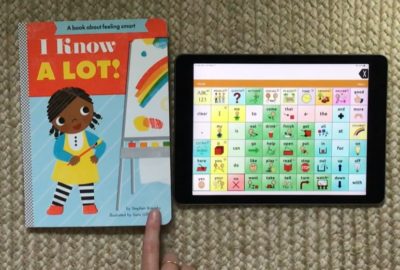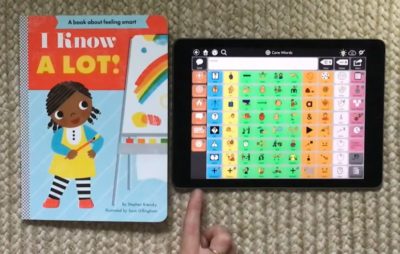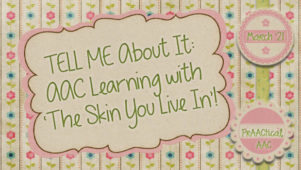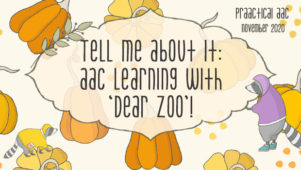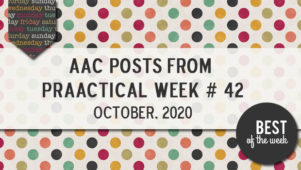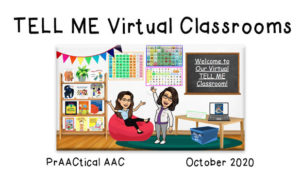TELL ME About It: AAC Learning with ‘I Know a Lot!’!

 It’s time for another post with book-related ideas for supporting core vocabulary learning in preschool classrooms. Jeanna Antrim and Maggie Judson are back with another guest post in support of preschool teachers who are implementing the TELL ME program with their young students.
It’s time for another post with book-related ideas for supporting core vocabulary learning in preschool classrooms. Jeanna Antrim and Maggie Judson are back with another guest post in support of preschool teachers who are implementing the TELL ME program with their young students.
Maggie and Jeanna are speech-language pathologists who work in the Assistive Technology Department for the Belleville Area Special Services Cooperative (BASSC) in southern Illinois. They are AT/AAC facilitators and provide evaluations, direct therapy, consultations, and trainings with school teams.
:::::::::::::::::::::::::::::::::::::::::::::::::::::::::::::::::::::::::::::::::::::::::::::::::::
TELL ME About It: AAC Learning with ‘I Know a Lot!’ by Stephen Krensky
TELL ME About The Book
The second book in this new series is “I Know a Lot!”. If this is a new title for you, you will LOVE the adorable illustrations, simple text, repeated phrases, as well as the focus on adjectives! And remember last month how we talked about following the CAR (Comment – Ask – Respond)? “I Know a Lot!” is a GREAT book to practice that instructional strategy, as the pictures easily lend themselves to making simple comments (“Look, snow! Brrrr.”). Such a fun book to use during shared reading! 
Book Focus: I Know a Lot
- Core Words (BOW WOW Words): I, KNOW, CAN, TELL
- Additional Words (Tiger Talk Words): today, later
- Concept Vocabulary: adjectives (ex. heavy, light, bright, dark, hot, cold)
- Book Concept: title
- Special Letters: h, f, i, s, b, l, e, r, w, k
TELL ME About Reading
Repeated Reading Focus: Letter-Sound Correspondence Activities
Letter identification and letter-sound correspondence activities are great for drawing attention to print and providing additional exposure to the special letters, their names, and their sounds! According to Dr. Karen Erickson (2017), one of the goals of emergent literacy instruction includes alphabetic and phonological awareness. Which explains why a critical component to the TELL ME program is infusing letter-sound correspondence learning throughout the day. While you can address this each day in the writing lesson, other activities can easily be incorporated to work in extra practice!
- Sing a fun name song during morning circle time! Sing the “Bingo Was Their Name-O” song using the names of the students – “I like to say good morning to a friend I like a lot, oh! L-O-U-I-S, L-O-U-I-S, L-O-U-I-S, and ‘Louis’ is their name, oh!”. You can alternate saying the letter names and saying the letter sounds each time you sing it!
- Have a letter sort center in your classroom. The student sorts the capital and lowercase versions of the letter of the day into their coordinating baskets.
- Role-Playing with the special letter! Students can role-play professions that begin with one of the special letters, let’s say the letter b: Baker, Banker, Biologist, Barber, Botanist – “We are going to pretend to be people that start with the letter b.” Extra points if you provide props and costumes!
- Go on a letter hunt! Take a walk in the school or outside and look for signs that include the letter of the day. Letter and letter-sound practice doesn’t have to be a set activity or time in the day. You can work it in throughout the day!
- Do a letter seek-and-find sensory bag or box. In addition to the fun sensory material (e.g., sand, water beads, or gel) have capital and lowercase versions of the letter of the day!
- Add in some explicit practice! Show a letter card and say the letter’s sound a few times. Then include this letter card with a few others displayed to the student. Say the target sound and have the child select the corresponding letter card, providing support as needed. Allow him or her to practice this a few times!
Adaptation Idea: Highlight the Target Words
A great way to adapt a book to draw attention to core words? Bring out the highlighter! Highlight the core words in the book with colored tape or a highlighter marker. Not only will this draw your students’ attention to the words, but it will provide you with a visual reminder to provide aided language input for the target words during reading! 
TELL ME About Writing
Writing is a big part of a TELL ME classroom! See below for ideas!
Predictable Chart Topic 
Title: Things I Know About!
Sentence frame: I know about _______.
FUNctional Writing Activity
Classrooms often include visuals for the centers available during instruction or free time. Why not let your students get in on this?! Have students write labels or signs for the different classroom areas, such as the library, kitchen, circle area, computers, etc. This is a great activity for teachers to “create or take advantage of many opportunities to demonstrate various aspects of writing throughout the day (Erickson & Koppenhaver, 2020, pg. 78).” Working in writing opportunities whenever you can allows for extra experience and practice for our students!
TELL ME More
Below are some specific ideas on how to implement “I Know a Lot!” in your therapy sessions and classrooms TELL ME-style!
Aided Language Input Tip – Team Practice/Warm-up
Team Meeting: During your weekly team meeting, dedicate some time to discussing, brainstorming, and practicing skills all about TELL ME. This is a natural time to chat with staff about the focus for instruction for the week. Feel prepared by using a lesson planning sheet! Doing activities to get comfortable and familiar with the AAC systems and the location of words is an excellent way to get everyone on the same page! Take turns finding I, KNOW, CAN, TELL on the manual communication boards. Practice saying a few sentences that contain the words while touching them on the manual communication boards. Take a few minutes to read through the book “I Know a Lot!” as a group while practicing aided language input for the words I, KNOW, CAN, TELL. Practice makes progress!
Other ways to incorporate support for classroom staff to implement a TELL ME week:
- Post the focus core words in a central spot in the classroom so that everyone can easily be reminded of the words
- Include a little cheat sheet of the focus concepts on lanyards
- Put a sticky note reminder on data sheets to keep that core word game strong during different activities during the school day

- Highlight the core words I, KNOW, CAN, TELL on the manual communication boards to make it easy to see and find the target words

- Provide staff with verbal reminders to incorporate those core words – I, KNOW, CAN, TELL – as they are going about the day
- Example: “Remember, you can work on the core words while you are…
Embedding Core into the Daily Routine – Morning Circle Time
Morning circle time is such a routine-based activity within the preschool classroom, making it a natural time to incorporate those core words into different rote phrases and scripts. Having some predetermined scripts can be a supportive way for communication partners in the classroom to become comfortable with targeting core words and providing aided language input on AAC systems.
Here are some examples:
- Weather: Let’s look out the window so we CAN TELL about the weather. I see the sun shining!
- ABC: Our letter of the day is ‘h’. Let’s find ‘h’! TELL me the sound ‘h’ makes.
- Attendance: Greeting Song: I KNOW who is here today. I see Bella. I KNOW Bella is here today. Hi Bella!
- Class Jobs: Let’s see who CAN help with our jobs today. This week Sanji CAN help be line leader!
Data Collection Idea – Being Specific with Communication Functions
When it comes to showing progress, it can be easier to demonstrate growth for emergent communicators when goals and objectives are written with autonomous communication in mind (the student saying whatever they want to say, whenever they want to say, to whomever they want to say it to). A great way to think through a goal is to consider how you want the student to show progress – by using an increased amount of communication functions, communicating with more partners, communicating in more settings, or increasing their initiation of communication, as a few examples.
Let’s take the idea of showing progress by increasing the number of communication functions used. If a student has down the functions of labeling, requesting preferred items, and greeting, awesome! Build on that! In the objective, you can write something like “__ will use multi-modal communication to increase their use of communicative functions (i.e. commenting, directing, protesting, asking questions) by two or more functions above the present level, when provided with ongoing aided language input.”
This objective allows us to show that the student is growing in their communication skills while keeping autonomous communication as the ultimate goal. As described perfectly by Kate McLaughlin (@the.aac.coach), “autonomous communication really needs to be at the center of our teaching, so our goals need to reflect that. When we write goals that focus on emergent communicators using specific words or even specific communicative functions, we set the stage for prompting. We have to be able to follow the student and focus on what they want to say (2020).”
Virtual Learning Resource – Tarheel Reader
Families are more likely to carry over the AAC system at home during everyday activities that they are comfortable with, which are already a part of the daily routine. Reading may be one of those activities, which is why we love using Tarheel Reader! With Tarheel Reader you can:
- Search for the words I, KNOW, CAN, TELL to find books that go along with the target core words for “I Know a Lot!”
- Access simple books that provide a repeated target word, or download the book and adjust the text to include a repeated target word.
- Print off books and provide to your classroom staff for their libraries, and send home to families for carry-over practice.
- Connect switches to a computer for independent reading time for students who require access to switches.
- Use as a platform to publish books after engaging in a predictable chart writing activity.
BONUS Virtual Learning Resources!
- Check out Jeanna’s @speechwithoutlimits resources again this month for additional virtual learning resources for the target core words! I YouTube video, I boom deck, KNOW YouTube video, KNOW boom deck, CAN YouTube video, CAN boom deck, TELL YouTube video, TELL boom deck.
- Check out Maggie’s @the.bookish.slp resources again this month for additional virtual learning resources for the target core words! CAN boom deck, CAN YouTube videos, CAN digital book, CAN TarHeel Game Play.
TELL ME at Home – Creating a Reading Habit at Home
We love the concept of advertising for literacy! It is a simple habit to create by just keeping books out and visible within your home’s different areas! This invites our children to pick up a book and explore and read. Some examples include:
- On the table during Breakfast/Snack
- On your coffee table in the living room
- In baskets in the playroom
- On night tables in the bedroom
- In the car
Self-Reflection Tip – “Each Student Has an Accessible Way to Say Core Words”
The TELL ME program is all about helping us as educators develop good AAC teaching practices and routines that we can implement when planning other lessons. But to do this, we have to reflect on how we are providing instruction. Last month we discussed creating a successful communication atmosphere for the school year by making AAC easily accessible (think: manual communication boards EVERYWHERE!).
This month, reflect on this with the question “Each student has an accessible way to say core words,” from the fidelity checklists available in the TELL ME program. 
Would you answer this question as:
- ALL
- SOME, or
- FEW of your students?
If, after reflection, you answer this as SOME or FEW, that’s okay! We all start somewhere! We encourage you to spend some time actively thinking through what changes you can make to your teaching practices and routines to support each student in having consistent access to core words.
Because remember: self-reflection and receiving constructive feedback helps you plan for your next session and get better at providing TELL ME-style instruction!
Video Read-Alouds
Check out the videos of us reading the book “I Know a Lot!” while providing aided language input using some popular AAC apps.
———————————————————————————————————————
To read more about how we prepare for a TELL ME week, check out our previous posts in the TELL ME About It series!
Be sure to check back next month as we work through the TELL ME manual and share activities, teaching strategies and implementation tips for the next book in this new series, “Dear Zoo”!
RESOURCES and REFERENCES
- Erickson, K. (2017). Comprehensive Literacy Instruction, Interprofessional Collaborative Practice, and Students With Severe Disabilities. American Journal of Speech-Language Pathology, 26, 193-205. doi:10.1044/2017_AJSLP-15-0067
- Erickson, K,. & Koppenhaver, D. (2020). Comprehensive Literacy for All: Teaching Students with Significant Disabilities to Read and Write. Baltimore, MA: Paul H. Brookes Publishing Co.
- McLaughlin, Kate. How I Do It… Emergent AAC Goal Writing. (2020, July 7). Retrieved September 23rd from https://drive.google.com/drive/u/0/folders/1sbmyoOomGLq6tby4VLzETmFHHYSl6kFB
- You can purchase the TELL ME manual from the Attainment Company or from ASHA.
- You can learn more about the program by watching the webinar TELL ME: AAC for the Preschool Classroom presented by Dr. Carole Zangari, available from Saltillo (bit.ly/2RNpykn).
Follow us on Instagram @basscAAC and subscribe to our YouTube channel (basscAAC) for more AAC implementation ideas!
Other Posts in the TELL ME About It Series
- YEAR 1
- TELL ME AAC Literacy Kits
- Brown Bear, Brown Bear
- I Went Walking
- From Head to Toe
- Here Are My Hands
- What Do You Like?
- Go Away Big Green Monster
- https://praacticalaac.org/praactical/tell-me-virtual-classrooms/No, David
- Come Out and Play, Little Mouse
- The Lunch Box Surprise
- If You’re Angry and You Know It
- Max’s Breakfast
- TELL ME Virtual Classrooms
- YEAR 2
Filed under: Featured Posts, PrAACtical Thinking
Tagged With: TELL ME
This post was written by Carole Zangari

